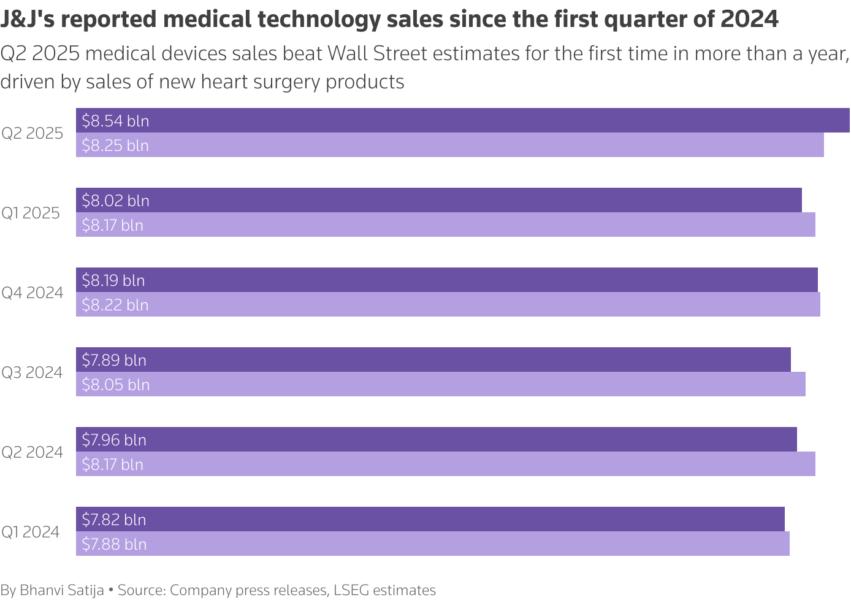Johnson & Johnson lifts 2025 forecast, halves tariff cost outlook
- J&J halves 2025 tariff cost outlook to $200 million
- J&J beats Q2 earnings expectations, raises 2025 sales forecast
- Analyst sees core business strong, consistent 5% sales growth
- Shares increase nearly 6% in morning trading
Johnson & Johnson JNJ halved its expectations for costs this year related to new tariffs and raised its full-year sales and profit forecast on Wednesday after a strong quarter for flagship cancer drug Darzalex and its cardiovascular devices.
The company's shares rose 5.9% to $164.29 in morning trade.
J&J said it now expects about $200 million in tariff-related costs this year, exclusively tied to its medical devices unit, saying it had benefited from the Trump administration’s pause on China levies and other duties. It had previously pegged costs at about $400 million starting in the second quarter.
J&J's Chief Financial Officer Joe Wolk told Reuters the company was able to absorb those costs and still raise its profit outlook, adding that he expected the impact this year to be minimal.
He noted that it was too soon to predict tariff impacts for 2026: "It’s such a fluid environment, we’ll have to wait and see."
The company will look to reinvest the difference in its product pipeline, a J&J executive said during an investor call.
Imports from most major trading partners are currently subject to levies of at least 10%, but in recent days U.S. President Donald Trump has threatened 30% tariffs on the European Union and 50% on Brazil. Trump plans separate pharmaceutical tariffs and recently said they could be delayed, but eventually be as high as 200%.
China is a key market for J&J's device business, although it does not disclose how much revenue it generates from the country.
"For J&J, it's mostly what they sell into China," said Jeff Jonas, portfolio manager at Gabelli Funds, which owns shares of the company. Jonas added that while the final rate of tariffs remains unknown, J&J has made the necessary cost cuts to offset impact.
The drug and medical device maker beat Wall Street expectations for the second quarter, posting adjusted earnings of $2.77 per share versus analyst expectations of $2.68 per share, according to data compiled by LSEG.
Quarterly sales stood at $23.74 billion, beating analysts' expectations of $22.84 billion.
Citing robust quarterly performance, J&J raised its 2024 sales forecast by about $2 billion and above analyst expectations of $91.5 billion, upping its range to $93.2 billion–$93.6 billion.
J&J said it expects to earn $10.80 to $10.90 per share on an adjusted basis in 2025, compared with its previous forecast of $10.50 to $10.70 per share.
J.P. Morgan analyst Chris Schott said in a note that J&J’s roughly 25 cents profit guidance boost outpaced expectations, but about 17 cents of that comes from a weaker dollar. He added that he sees the drugmaker's core business as strong and on track for consistent 5% or more sales growth.
The drugmaker's outlook excludes any effects from Trump’s "most favored nation" drug pricing order from May, a J&J executive said during an investor call. The order directs pharma companies to slash U.S. drug prices to international levels.
Excluding foreign currency impact, medical device sales jumped 6.1% to $8.54 billion, outpacing predictions of $8.25 billion. J&J saw gains from new products including Varipulse and Trupulse, which are used for pulsed field ablation, as well as double digit growth for Abiomed products, specifically its Impella heart pumps.
Jonas said he was surprised by the stock increase, given that strong medical device volumes had been mostly anticipated, with both insurers and hospitals indicating robust surgical activity during the quarter.

J&J is betting on cardiovascular and surgery - especially with its move into robotics - as the key engines of growth for its medtech unit, an executive said during Wednesday's investor call.
Darzalex, a blood cancer therapy launched in 2015, brought in second-quarter sales of $3.54 billion, compared with analysts' expectations of $3.38 billion.